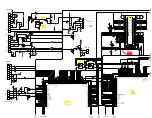
6-18
Phaser 440 Color Printer
6
Troubleshooting
Image processor self-diagnostics
Image processor rear panel switches for self-testing
The image processor features four types of self-diagnostic modes. The type of
self-diagnostics run depend upon the position of rear panel DIP Switches 2, 3
and 4. The switch combinations are listed here.
Switch
2
3
4
Self-diagnostic mode
↓ ↓ ↓
Normal power-up self-test
↑ ↓ ↓
Verification self-tests
↓ ↑ ↓
Skip the power up self tests
↑ ↑ ↓
Manufacturing service test
↓ ↓ ↑
Print configuration page
↑ ↓ ↑
not used
↓ ↑ ↑
not used
↑ ↑ ↑
not used
The selected self-diagnostics begin upon power-up or after a hardware reset
(DIP Switch 1 toggled).
Normal power-up self-test
This test requires no paper or user interaction. If a problem is encountered with
the image processor's expansion memory or other options, then the information
is printed on the printer's startpage. Normal power-up tests take slightly longer
than one minute to complete for a fully configured printer.
The STATUS LED indicate a self-diagnostic test failure by remaining either on or
off. See the following table for a list of the diagnostics tests. The STATUS LED
flashing in a regular one flash-per-second rate means
no errors were detected and
the image processor's CPU is running.
No self-diagnostics
The printer skips all self-tests and goes directly to PostScript initialization.
Verification self-test
This continuously looping test series requires no paper or user interaction.
Disconnect all host cables from the printer before starting the test. A fully
configured printer takes slightly longer that one minute.
Note
Be sure to disconnect any terminal or host connected to the serial port
if you do not want it to receive the self-test messages.
















































